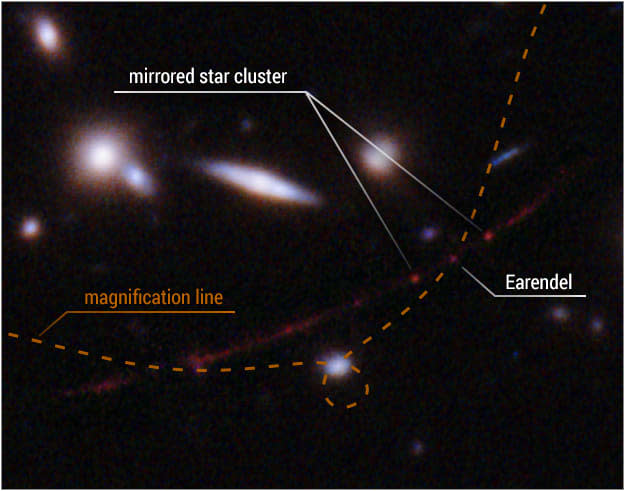The Hubble Space Telescope Spots the Oldest Star We’ve Ever Encountered

NASA’s Hubble Space Telescope, a fixture of astronomy for more than three decades, continues to deliver the hits we know and love. Just this week, Hubble broke its own record and managed to spot the most distant individual star ever to be observed—a flicker of light 12.9 billion light-years away that scientists are calling Earendel.
“We almost didn’t believe it at first,” Brian Welch, an astronomer at Johns Hopkins University in Baltimore and lead author of the new findings published in Nature, said in a statement. “Normally at these distances, entire galaxies look like small smudges, with the light from millions of stars blending together,” said Welch. Discerning light from a single object so far away like this has never been accomplished before. The previous record-holding star, detected by Hubble as well in 2018, was only 9 billion light-years away.

A magnified, annotated view of Earendel.
Observing objects in space really means observing the light that’s traveled those vast distances. So peering at Earendel, which is about 50 times more massive than the sun and a million times brighter, actually means seeing the star as it looked 12.9 billion years ago, when the universe was still in its infancy.
Finding Earendel, which means “morning star” in Old English, is a remarkable feat for a piece of technology that was first launched in 1990. Hubble’s hardware has faced quite a few problems in recent years, forcing NASA engineers to wield it more carefully and shut it down more frequently to troubleshoot issues that come up.
How a Cosmic Flux in Gravity Might Have Helped Kill Off the Dinosaurs
Luckily, Hubble’s successor, the James Webb Space Telescope, will be able to pick up the baton soon enough. Launched last December, Webb should be able to learn what Earendel is made of and how it may have evolved once it begins science operations this summer. Astronomers hope to use that data to learn more about what the universe looked like just after the Big Bang and how its evolution led to the formation of stars like the sun, and planets like Earth.
Got a tip? Send it to The Daily Beast here
Get the Daily Beast's biggest scoops and scandals delivered right to your inbox. Sign up now.
Stay informed and gain unlimited access to the Daily Beast's unmatched reporting. Subscribe now.

